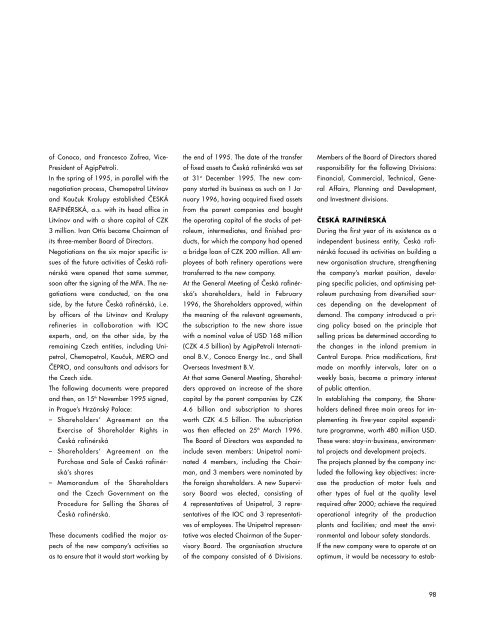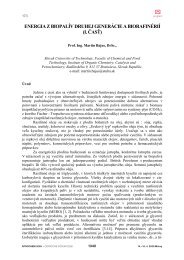THE CENTURY OF PETROL - Petroleum.cz
THE CENTURY OF PETROL - Petroleum.cz
THE CENTURY OF PETROL - Petroleum.cz
Create successful ePaper yourself
Turn your PDF publications into a flip-book with our unique Google optimized e-Paper software.
of Conoco, and Francesco Zofrea, Vice-<br />
President of AgipPetroli.<br />
In the spring of 1995, in parallel with the<br />
negotiation process, Chemopetrol Litvínov<br />
and Kauãuk Kralupy established âESKÁ<br />
RAFINÉRSKÁ, a.s. with its head office in<br />
Litvínov and with a share capital of CZK<br />
3 million. Ivan Ottis became Chairman of<br />
its three-member Board of Directors.<br />
Negotiations on the six major specific issues<br />
of the future activities of âeská rafinérská<br />
were opened that same summer,<br />
soon after the signing of the MFA. The negotiations<br />
were conducted, on the one<br />
side, by the future âeská rafinérská, i.e.<br />
by officers of the Litvínov and Kralupy<br />
refineries in collaboration with IOC<br />
experts, and, on the other side, by the<br />
remaining Czech entities, including Unipetrol,<br />
Chemopetrol, Kauãuk, MERO and<br />
âEPRO, and consultants and advisors for<br />
the Czech side.<br />
The following documents were prepared<br />
and then, on 15th November 1995 signed,<br />
in Prague’s Hrzánsk˘ Palace:<br />
– Shareholders’ Agreement on the<br />
Exercise of Shareholder Rights in<br />
âeská rafinérská<br />
– Shareholders’ Agreement on the<br />
Purchase and Sale of âeská rafinérská’s<br />
shares<br />
– Memorandum of the Shareholders<br />
and the Czech Government on the<br />
Procedure for Selling the Shares of<br />
âeská rafinérská.<br />
These documents codified the major aspects<br />
of the new company’s activities so<br />
as to ensure that it would start working by<br />
the end of 1995. The date of the transfer<br />
of fixed assets to âeská rafinérská was set<br />
at 31st December 1995. The new company<br />
started its business as such on 1 January<br />
1996, having acquired fixed assets<br />
from the parent companies and bought<br />
the operating capital of the stocks of petroleum,<br />
intermediates, and finished products,<br />
for which the company had opened<br />
a bridge loan of CZK 200 million. All employees<br />
of both refinery operations were<br />
transferred to the new company.<br />
At the General Meeting of âeská rafinérská’s<br />
shareholders, held in February<br />
1996, the Shareholders approved, within<br />
the meaning of the relevant agreements,<br />
the subscription to the new share issue<br />
with a nominal value of USD 168 million<br />
(CZK 4.5 billion) by AgipPetroli International<br />
B.V., Conoco Energy Inc., and Shell<br />
Overseas Investment B.V.<br />
At that same General Meeting, Shareholders<br />
approved an increase of the share<br />
capital by the parent companies by CZK<br />
4.6 billion and subscription to shares<br />
worth CZK 4.5 billion. The subscription<br />
was then effected on 25th March 1996.<br />
The Board of Directors was expanded to<br />
include seven members: Unipetrol nominated<br />
4 members, including the Chairman,<br />
and 3 members were nominated by<br />
the foreign shareholders. A new Supervisory<br />
Board was elected, consisting of<br />
4 representatives of Unipetrol, 3 representatives<br />
of the IOC and 3 representatives<br />
of employees. The Unipetrol representative<br />
was elected Chairman of the Supervisory<br />
Board. The organisation structure<br />
of the company consisted of 6 Divisions.<br />
Members of the Board of Directors shared<br />
responsibility for the following Divisions:<br />
Financial, Commercial, Technical, General<br />
Affairs, Planning and Development,<br />
and Investment divisions.<br />
ČESKÁ RAFINÉRSKÁ<br />
During the first year of its existence as a<br />
independent business entity, âeská rafinérská<br />
focused its activities on building a<br />
new organisation structure, strengthening<br />
the company’s market position, developing<br />
specific policies, and optimising petroleum<br />
purchasing from diversified sources<br />
depending on the development of<br />
demand. The company introduced a pricing<br />
policy based on the principle that<br />
selling prices be determined according to<br />
the changes in the inland premium in<br />
Central Europe. Price modifications, first<br />
made on monthly intervals, later on a<br />
weekly basis, became a primary interest<br />
of public attention.<br />
In establishing the company, the Shareholders<br />
defined three main areas for implementing<br />
its five-year capital expenditure<br />
programme, worth 480 million USD.<br />
These were: stay-in-business, environmental<br />
projects and development projects.<br />
The projects planned by the company included<br />
the following key objectives: increase<br />
the production of motor fuels and<br />
other types of fuel at the quality level<br />
required after 2000; achieve the required<br />
operational integrity of the production<br />
plants and facilities; and meet the environmental<br />
and labour safety standards.<br />
If the new company were to operate at an<br />
optimum, it would be necessary to estab-<br />
98



